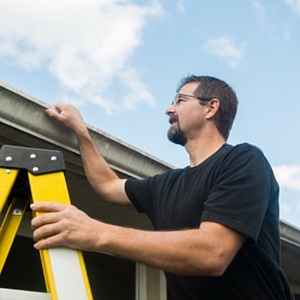Keep the Roof Over Your Head in Good Condition

When Kevin and Christina built their first house, water damage to the kitchen floor a year later wasn't part of the plan. The fact that the damage came from the roof was even more of a surprise. The problem came from loose flashing around the door that allowed water to seep in, damaging not only the floor, but the wood around the door. Fortunately, the house was still under warranty and the builder fixed the problem, but if it was an older home, this would have been a costly repair for them.
Roof maintenance is generally not something you think about until you start having problems, but it's something you need to do every spring and fall. If Kevin and Christina had noticed the loose flashing sooner, they could have avoided the level of damage to their house.
What to Look For
If you think you have to get on a ladder to inspect your roof, and ladders make you nervous, rest assured that much of your roof inspection can be done from the ground. Besides, it's better for you and for your roof if you do not walk on it.
Let's start with the flashing. (You can do this with binoculars if you don't want to use a ladder.) Flashing is a strip of material (usually sheet metal, aluminum, plastic or roofing felt) you will find around any roof openings like a chimney, skylight, vent pipe, dormer window, door, etc. Because flashing is used to keep water from seeping in to those areas, it should not be loose or it will not be effective.
It's also important to inspect the shingles. You don't want to see shingles that are curling at the edges, buckling, warped or blistering as this is a sign that the shingles are aging and may need to be replaced. Discolored, cracked or missing shingles are also cause for concern. If you have asphalt shingles, you might notice they are covered with a granular coating that's designed to protect it from the elements. If the granules come off, the shingle can crack or break, allowing water to seep under it and start to damage the roof's foundation.
You will also need to make sure your roof is not misshapen in any way. Are there bulges, valleys or waves? There shouldn't be, and if you see any of those things, it's an indication of a problem.
Keep it Clean
Seeing green? It could be mold or moss growing on your roof, and it needs to be cleaned off because of the damage it can cause. While it may be tempting to use a power washer, this can remove the protective granules from asphalt shingles. Instead, spray a moss removal solution on the roof and gently brush it off. Better yet—leave it to a professional.
Finally, check your gutters and downspouts to be sure they are free from debris. If they are clogged, it can cause water to back up, whether it's from heavy rain or a result of snow and ice melting. When water backs up, it can seep under shingles, damaging not only the shingles but the wood underneath them. Usually that type of damage isn't evident right away—you only notice it by water marks on your ceiling. At that point, you have to fix the roof and the ceiling. If the water has been there long enough, there's a possibility that mold may have developed as well, so you'll have to clean that out before it does more damage.
The average lifespan of a roof is 20 years, and the average mortgage is for 30 years. To get the most out of your roof, perform regular roof inspections and maintenance so that little problems don't become big ones. After all, an ounce of prevention is worth a pound of cure.
